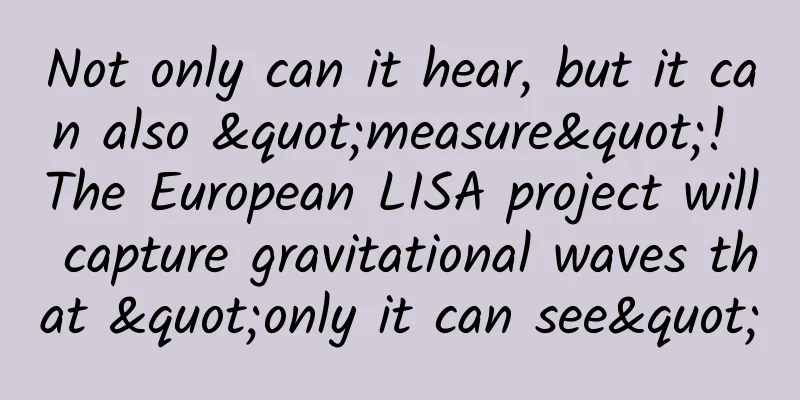Not only can it hear, but it can also "measure"! The European LISA project will capture gravitational waves that "only it can see"

|
Author: Han Wenbiao, researcher at Shanghai Astronomical Observatory, Chinese Academy of Sciences Did you know that gravitational waves, which could only be "heard" on the ground, can soon be measured in space! Today we are going to talk about the LISA (Laser Interferometer Space Antenna) project, a space gravitational wave detector officially launched by Europe this year. Its full name is Laser Interferometer Space Antenna, and its goal is to detect low-frequency gravitational waves in space. You can think of gravitational waves as ripples in space-time in the universe. Just like throwing a stone into a pond will cause ripples on the water surface, the violent movement of celestial bodies such as black holes or neutron stars will also produce such ripples. These ripples are actually fluctuations in space-time, propagating at the speed of light, and we call them gravitational waves. So how does LISA detect gravitational waves, and why do we need to measure gravitational waves in space? Let me give you a detailed introduction. The principle of LISA is actually very similar to the existing gravitational wave detector Laser Interferometer Gravitational-Wave Observatory (LIGO), both of which use laser interferometry technology. LIGO uses a spectroscope to split a laser beam into two beams, which are reflected back and forth on two long arms. When a gravitational wave passes by, the length of the two reflecting arms will change. This change is extremely small, perhaps one thousandth of the proton radius, but it will also cause the phase of the two laser beams to change. When they meet again and interfere, the brightness will change over time. Gravitational wave detectors use this principle to detect very weak gravitational wave signals. Unlike LIGO on the ground, LISA moves this laser interferometer into space. It consists of three identical spacecraft, orbiting the sun with the Earth tens of millions of kilometers behind the Earth. The orbit is designed very cleverly, so that the three spacecraft always maintain an equilateral triangle, and the three spacecraft are 2.5 million kilometers apart from each other. This is equivalent to a laser arm length of 2.5 million kilometers, far longer than LIGO's four kilometers. Therefore, the difficulty of engineering technology can be imagined. At such a long distance, it is very challenging to ensure that the laser emitted from 2.5 million kilometers away can be captured. The complex environment in space makes the spacecraft subject to various non-gravitational interferences, which will lead to the failure of detecting gravitational waves. To this end, scientists used a magical technical solution. Each spacecraft is equipped with a suspended small cube made of gold-platinum alloy, which is isolated in a vacuum cavity. Gravity has a magical property that there is no way to shield it, but other interactions such as electromagnetic force can be shielded. In this way, these small cubes only feel the effect of gravity. But the spacecraft carrying it is subject to various interferences. For this reason, it is also necessary to use drag-free technology to precisely control the spacecraft so that the spacecraft moves with the small cubes. When gravitational waves pass through, the distance between these mass blocks will change slightly. LISA uses laser interferometry technology to accurately measure these changes, even if they are as small as a few picometers (a picometer is one trillionth of a meter). Such a long arm length enables LISA to detect gravitational wave signals in the millihertz band. These low-frequency gravitational waves usually come from supermassive black holes with a mass of millions of solar masses. This is something that the ground-based LIGO cannot detect. Due to LISA's ultra-high sensitivity, it can detect various gravitational wave signals just after the birth of the universe, revealing scientific knowledge about the early universe for us. Of course, our country is not willing to lag behind and has proposed two space gravitational wave detection projects, Taiji and Tianqin, in preparation to compete with LISA in space and jointly explore the mysteries of the universe. This article is a work supported by the Science Popularization China Creation Cultivation Program Author Name: Han Wenbiao Reviewer: Liu Congliang, Researcher, National Space Science Center, Chinese Academy of Sciences Produced by: China Association for Science and Technology Department of Science Popularization Producer: China Science and Technology Press Co., Ltd., Beijing Zhongke Xinghe Culture Media Co., Ltd. |
<<: National Eye Care Day丨Don’t believe these 10 rumors about eyes →
>>: Why are some people not nearsighted even though they are playing with their phones? !
Recommend
When I woke up, my single eyelids turned into double eyelids in a second. I encountered the bug of having double eyelids.
Have you ever had the experience of waking up wit...
Doushen Chinese Language "24 Lessons on Primary School Reading Techniques"
Doushen Chinese Language "24 Lessons on Prim...
In-depth information | The most comprehensive guide to Zhihu information flow advertising is online
As the largest knowledge sharing platform in Chin...
Amazing marine diatoms! Scientists discover new mechanism of diatoms using light energy
Produced by: Science Popularization China Author:...
Marketing plan strategy!
The outline is as follows: 1. Clarify various pro...
What is the unknown fate of shared bicycles?
The shared bicycle industry has been in the news r...
Zhang Jike and Jing Tian's romance is public, how should major brands write copywriting to take advantage of it?
At 7:21 this morning, Zhang Jike posted this Weib...
Under the trigger of "one yuan course", how can online education platforms seize the high ground?
In 2011, New Oriental Youneng Middle School took ...
The Noah's Ark of plants has carried 2.4 billion seeds丨Nature Trumpet
Welcome to the 30th issue of the Nature Trumpet c...
Baidu bidding multi-account promotion strategy!
How to formulate a bidding multi-account delivery...
Don't come over here! Don't come over here! If you come over here again, I will exterminate your entire clan!
Ever since the ancient continents broke apart, th...
The connotation and realization path of common prosperity Baidu Cloud Download
Resource introduction of the connotation and real...
Are there two volcanoes called Datun in China? One in the south and one in the north! If you don’t believe me, check it out →
The Fanjiatun-Datun volcanic group in Changchun C...
Event operation and promotion: How to plan the core gameplay?
As usual, let me give you a definition: Operating...





![[Smart Farmers] Is the “fresh and clean” Aster a “nutrient plunderer” with great destructive power?](/upload/images/67f213e04101d.webp)



